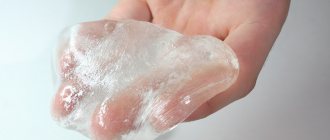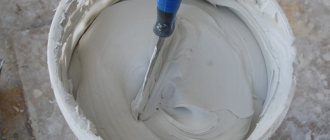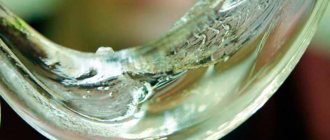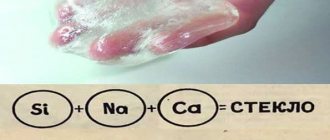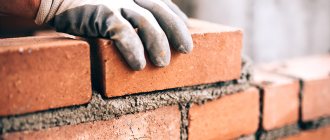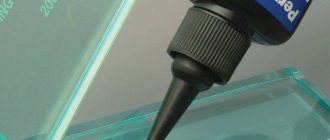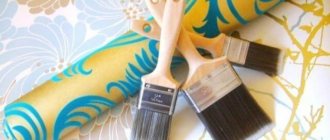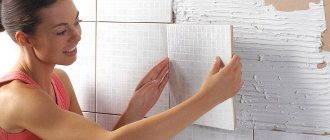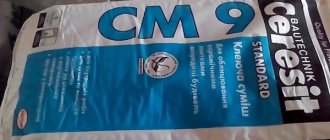Comparison of potassium and sodium based glass
Potassium and sodium solutions are available. They have almost identical properties, but there are also differences. General properties:
- Dilutes well with water.
- When completely dry, they form a durable waterproof film.
Differences:
- The sodium mixture is cheaper.
- The potassium layer is more resistant to atmospheric changes and chemicals.
- The sodium layer has better fire resistance and antiseptic properties.
- When processing a surface, the potassium mixture does not leave whitish spots and has an anti-reflective property. The sodium type does not have such properties.
- The potassium product is more viscous, but the sodium product is used for strength in the cement composition.
Types of cement mortars using silicate glue
Scheme for preparing concrete mortar.
Waterproofing is required where the structure or structure will come into contact with moisture. Waterproof plaster is prepared from sand and cement, which are mixed in the proportions of 1 part cement: 2.5 parts sand. Then the solution must be diluted with water, in which silicate must be dissolved in a ratio of 15% of the volume of cement.
When waterproofing swimming pools, walls or ceilings, floors, ceilings or basements, a mixture is used in which ten parts of simple cement mortar are taken per one part of liquid glass (sand 3 parts, cement 1 part). Before using this mixture, the surface should be coated with one or two layers of pure silicate. For this it is best to use a hard brush or brush. Then wait until the surface is completely dry and then begin applying cement mortar.
Waterproofing wells requires the use of a 1:1 mixture, where one part of cement is taken of one part of sand and one part of liquid glass. The amount of water is calculated in such a way as to obtain a mobile mixture with a consistency reminiscent of liquid sour cream.
How to clean liquid glass from tiles?
During the renovation, the tiles got dirty with liquid glass.
In addition, they were not immediately noticed and ultimately cannot be washed off. How to clean so as not to spoil the glossy surface of tiles? comment
To favorites
Ivann a [820]
6 years ago
After repairs, it happens that sometimes stains from cement, whitewash or liquid glass remain on the tiles. The worst thing to wash off is liquid glass, which hardens very quickly and sticks tightly to the surface, so to avoid unnecessary problems, remove it immediately. If the stain is discovered after some time, you will have to tinker with it. To clean liquid glass from tiles you will need: a cloth, an old toothbrush, a blade, vinegar (not vinegar essence), a spray bottle, gloves (preferably rubber, thick ones), a sponge and some free time. To clean liquid glass from tiles, first try to soften the stain - place a cloth soaked in a mild vinegar solution on it and wait 30-40 minutes. Then try removing the stain with a toothbrush. If it still does not come off, take a blade and gently scrub until it is completely removed. Wash off the stain with hot soapy water and, after it is completely dry, look at the result, if everything works, wipe the stain with glass cleaner and polish, if not, repeat the procedure from the beginning . You will succeed!
Safety precautions during operation
The material used is safe and does not contain any harmful elements, but during preparatory or glass coating work itself, alkaline reactions occur when the product comes into contact with exposed areas of the skin.
Therefore, PPE is used during work. Work with rubber gloves and boots.
In the room where the work is being carried out, there should be a container with clean water in case of immediate washing of the skin area if glue gets on it. And the damaged area is treated with a vinegar solution, which acts as an anti-alkaline compound.
Advantages and disadvantages of use
The operational warranty is 5 years. During this time, there is a gradual decrease in the thickness of the protective layer, up to approximately 1 mm per year. To extend the life, experts recommend applying a layer of paint over the glass.
The composition completely penetrates into the structure of the coated material, filling the cracks and pores.
It is beneficial to add silicate directly to the concrete solution itself. At the same time, it becomes more transparent and stable. But the setting and hardening time is reduced, which is very important if the work is being done for the first time and leveling takes a lot of time. The frozen mixture is not suitable for reuse. Therefore, it is advisable, when pouring screeds over large areas, to prepare the solution in portions.
If more than 10% silicate is added to concrete, it will become weak and easily damaged by mechanical influence.
When the floor is filled with liquid glass, the result is a very even, smooth plane, a beautiful appearance, and maximum resistance to mechanical stress is achieved. This surface is easy to clean and prevents the emergence of pathogenic microorganisms. Therefore, such spraying is often used in hospitals.
The coating can be carried out independently, without the involvement of labor. This is an inexpensive material.
In certain options, additional materials are added that extend the service life of the interlayer.
